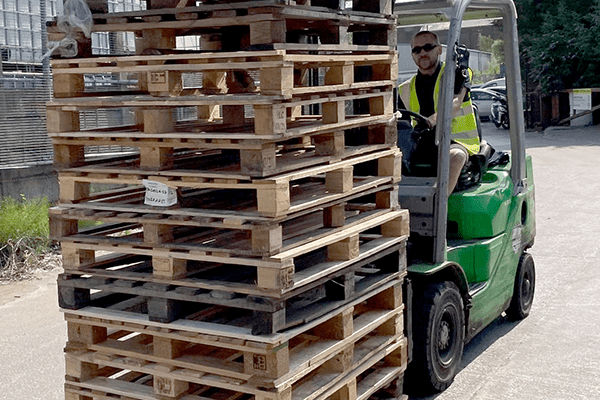With pallets in short supply, caring for them has never been so important. Keep your pallets in tip-top shape to keep them in good working order and they can be used again and again for many years – and can even be repaired.
Pallet Accidents
Pallet accidents can harm your team, and can also cause damage to your pallets, so it’s important to first understand how and why pallet accidents occur. The most common pallet accidents are caused by things like:
- Using damaged pallets
- Poor handling – staff should be trained to use appropriate equipment, and the correct loading/handling techniques: pallets are tough, but they are not indestructible
- Load weights – too often ‘any’ pallet is plucked from the pile, when each type has specific maximum load values
- Poor stacking – it’s always best to clear your site of unused pallets, but if you have to stack them they must be stacked safely
Get The Look
If you’re handling pallets, the chances are you are working in a busy, industrial setting like a warehouse. In these locations there are likely H&S requirements like high vis vests, but if you’re handling pallets there are a few additional pieces of kit you should also consider:
- A hard hat
- Steel toed boots
- Gloves
- Glasses
Proper safety gear will in turn reduce accident risk keeping your team and your pallets safer.
Forklifts & Jacks
Lifting pallets, loaded or unloaded, is a specialist skill.
Unloaded pallets can be lifted by hand if an appropriate technique is used. Pallets can weigh anywhere from 9kg to 23kg, and so even though you may feel capable of lifting one on your own, they were not designed to be lifted by the top boards and flung about. They are large, unwieldy objects and if lifting by hand we would recommend this is a 2-person job, especially if you’re not experienced. Lift them one at a time and keep them level. Do not slide them on and off of any other surface, and do not drop them onto a side or corner.
Preferably pallets should be lifted by the specialist machinery they were designed to be used with; a forklift or a pallet jack. But even with specialist equipment, incorrect usage can damage pallets. For example:
- Pushing, sliding or turning pallets on the floor using a jack, forklift, or any other method will put stress on the pallet structure and lead to damage. Pallets must be lifted.
- Short-Forking. If forklift or jack fingers are not inserted all the way through a pallet then the pallet is destabilised and stress will occur causing damage.
- Using incorrect fork width depending on the pallet type
- Tilting masts before the forks are properly inserted
Ensuring forklifts and jacks are used correctly, hence protecting your pallets, is a worthwhile long-term investment. Nobody should be operating a forklift unlicensed, and you should ensure licenses are checked for all new staff members. Additional ‘refresher training’ for forklift operators is available and should be strongly considered for your team members, regular retraining can help avoid accidents.
Pallet jacks are often considered to be simple equipment, but these manual machines can move huge weights and bulky loads. While a license isn’t needed, training should still be provided and documented. Especially for electric pallet jacks, which have similar capabilities to forklift trucks. Do not overlook this type of equipment simply because a license is not mandatory.
In addition, any managers and supervisors should be trained to maintain the equipment and to ensure regular maintenance of the equipment is carried out, as well as keeping employees up-to-date with training.
You can access HSE’s approved code of practice here for free.
Loading Pallets
Specific pallets have specific load weights and intended uses. For example, some pallets are intended for chemical barrels and so are able to hold a bulky weight which is not evenly spread across the pallet. Others are designed for lighter loads or are only suitable to carry their maximum load weight if it is evenly distributed across the whole pallet.
Not knowing which pallet suits which load, and just picking one out of a pile is a good way to risk accident, injury and damage to your load. If you want to know more about pallet types we have a great guide you can download here. If in doubt, call your pallet supplier who will be able to assist you in checking your pallets are fit for purpose.
When loading a pallet care should be taken to load gradually and evenly, distributing weight as uniformly as possible over the pallet. The height of the load should be no more than the longest base length of the pallet unless wrapping is used to further stabilise the load.
Securing loads on a pallet can also cause damage if done incorrectly, for example too much or too little tension from a binding material can cause a pallet frame to snap. Inspect your loaded pallet after applying wrapping, bands or bindings to check for any damage. Particular areas that can be stressed by wrapping are the deckboards. To prevent damage to your pallet and your load there are a variety of products which can provide protection; such as angle irons, edge protectors, and top boards.
Do not stand on or walk on pallets, this is not what they are designed for. They can be slippery when wet, and your foot may fall through causing an accident as well as damage to your pallet.
Stacking & Storing
If you have a surplus of pallets on-site and do not wish to return them to a supplier, then you need to ensure they are in a safe space, stacked directly one on top of the other.
If you have more than one type of pallet, you must stack them by type. Not only does this keep your pallets in better condition, it will be easier for you to select the right type of pallet when you come to use them again.
Never stand pallets on their sides, or lean them against a wall, this can be an H&S hazard and will increase the risk of the pallets falling and damage occurring.
And absolutely never leave your pallets in a pile. If you have no future use for them, or space to safely store them, contact us and we will clear your site for you.
Of course, loaded pallets are designed to be stored and can be stored in many different ways. If you are stacking loaded pallets you need to be aware of the load capacity for the bottom pallet, especially. Any issues with your base pallet can result in disaster, as can any ‘creep distortion’ occurring within the pallet load.
Racking or shelving is a safer option, as long as it is well maintained and your pallet types suit your racking type. Again, there will be some pallets which are not suitable for storing in certain types of racking. Always check with the manufacturer and speak with your pallet supplier for advice on the best pallet types for your specific requirements.
Pallet Damage & Repair
One of the humble wooden pallet’s greatest features is its reusability. A well cared for pallet can last many years, and with quality maintenance and repair it could last even longer.
If you suspect any of your pallets could be damaged, put them aside and have them assessed and repaired by experts.
The Universal Pallets team are highly experienced in pallet maintenance and repair. We will repair pallets correctly according to their intended end use. And any pallets that cannot be repaired will be responsibly recycled.
Suggested Actions
- Set-up routine pallet inspections
- Set-up routine forklift, jack and manual lifting training
- Inspect pallets before they are used
- Inspect racks and shelving regularly
- Send damaged pallets back to Universal Pallets for repair / recycle
- Clear unused pallets from your site – Universal Pallets can collect
- Keep your accident book up-to-date, monitor for pallet injuries, this is a good indicator that retraining and processes need to be updated
- Download our Ultimate Guide To Pallet Sizes to better understand pallet types (needs link)

